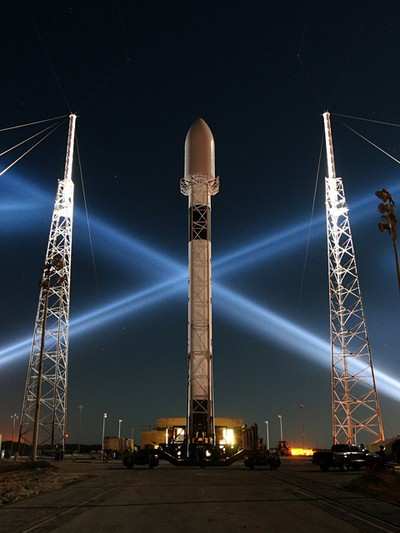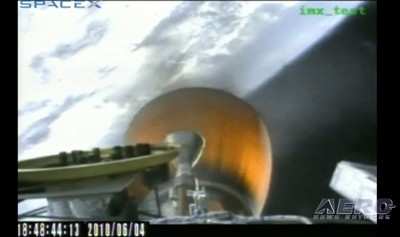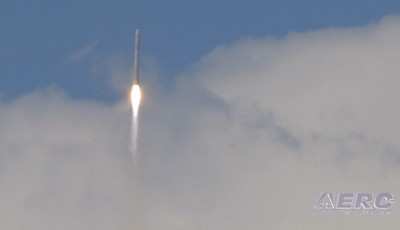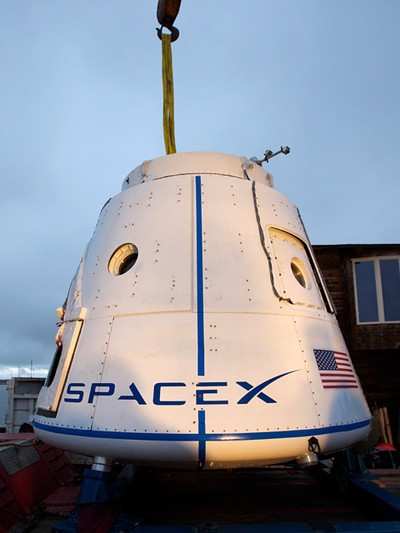Sat, Dec 04, 2010
Static Firing Was Aborted 1.1 Seconds Into A Planned 3 Second
Burn
By Wes Oleszewski
Friday morning SpaceX's second Falcon 9 launch vehicle attempted
a static firing test at Cape Canaveral's Launch Complex 40 in
preparation for a December 7th launch. That launch will be the
COTS-1 Demonstration mission. The static firing was aborted 1.1
seconds into a planned 3 second burn. It was later decided not to
proceed with a second attempt and the static firing was given a 24
hour scrub.

The original schedule called for the static firing to take place
at 9:00 am Eastern Time, however, the firing was subsequently
delayed. When the process was resumed, ignition came at 1:00 pm,
but was terminated automatically 1.1 seconds later. Reportedly an
abnormally high chamber pressure in engine number 6 of the first
stage's 9 engine cluster was sensed and the sequencer automatically
shut down the vehicle. Although SpaceX's streamlined launch system
allows for a very rapid recycle to another attempt at first stage
firing, it was reportedly decided that there was not enough time
remaining in the Easter Test Range's allotted window for the static
test and the event was scrubbed for 24 hours. SpaceX announced that
another attempt will be made on Saturday morning.

This was not the first time that a Falcon 9 launch vehicle has
been dealt a post-ignition shutdown on the pad due to one of its 9
engines. The first Falcon 9, which launched on June 4th of this
year, was also shut down at ignition. It was recycled and launched
successfully the same day.

Three months prior to that event, however, that same booster
aborted 2 seconds into its static test due to an engine issue that
the sensors caught.

It is the goal of next week's launch to perform the first COTS
demonstration flight where the Falcon 9 will place into orbit an
active version of SpaceX's Dragon space capsule. That capsule is
scheduled to make 3 orbits before reentering and parachuting to a
Pacific Ocean splashdown. COTS, the Commercial Orbital
Transportation Services, is a program by which NASA has contracted
two private companies to transport cargo to and from the
International Space Station following the retirement of the Space
Shuttle.
More News
Pilot Also Reported That Due To A Fuel Leak, The Auxiliary Fuel Tanks Were Not Used On June 4, 2025, at 13:41 eastern daylight time, a Piper PA-23, N2109P, was substantially damage>[...]
Have A Story That NEEDS To Be Featured On Aero-News? Here’s How To Submit A Story To Our Team Some of the greatest new stories ANN has ever covered have been submitted by our>[...]
From 2023 (YouTube Edition): Reflections on War’s Collective Lessons and Cyclical Nature The exigencies of war ought be colorblind. Inane social-constructs the likes of racis>[...]
Aero Linx: Colorado Pilots Association (CPA) Colorado Pilots Association was incorporated as a Colorado Nonprofit Corporation in 1972. It is a statewide organization with over 700 >[...]
High Speed Taxiway A long radius taxiway designed and provided with lighting or marking to define the path of aircraft, traveling at high speed (up to 60 knots), from the runway ce>[...]
 NTSB Prelim: Piper PA-23
NTSB Prelim: Piper PA-23 ANN FAQ: Submit a News Story!
ANN FAQ: Submit a News Story! Classic Aero-TV: One Mans Vietnam
Classic Aero-TV: One Mans Vietnam ANN's Daily Aero-Linx (07.03.25)
ANN's Daily Aero-Linx (07.03.25) ANN's Daily Aero-Term (07.03.25): High Speed Taxiway
ANN's Daily Aero-Term (07.03.25): High Speed Taxiway






